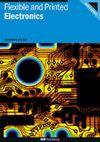Materials screening and characterization for functional printed automotive interiors parts
IF 3.2
4区 工程技术
Q3 MATERIALS SCIENCE, MULTIDISCIPLINARY
引用次数: 0
Abstract
Flexible printed electronics (PE) has attracted strong interest during the last two decades and is one of the successful trends in material science, representing the future of PEs. This research work evaluates the use of screen-printing technology and materials for producing functional circuits for automotive interior parts, which can be subsequently processed through in-mold electronics (IME). Since the selection of the materials to build the printed system is of utmost importance, this study evaluates combinations of commercial polycarbonate substrates (LEXAN 8A13E, DE 1-4 060007 and LM 905 2-4 160009) and silver-based inks (ME603, ME604 and CP 6680), all suitable for IME. Different electrically conductive tracks varying in width and spacing (0.5, 0.3 and 0.2 mm) and two capacitive sensors were printed. Tensile tests and surface energy characterizations of the different polycarbonate substrates were carried out, then morphological, electrical, and thermoforming studies were performed on the printed substrates. Morphological characterization showed successful printing for wider lines (0.5 and 0.3 mm), but problems with screen clogging occurred for smaller line widths (0.2 mm). The electrical conductivity of printed tracks was in accordance to the printed layer thickness and ink solids percentage. The proof-of-concept of the electrical functionality was successful, when integrating the sensors into the PCB with SMD LEDs. Thermoforming showed limited functionality, with the best overall performance observed for specific combinations of substrate and ink. In essence, the results indicate that although all the selected substrates and silver-based inks have great compatibility among themselves and can be considered as materials for the production of functional automotive interior parts, there is no ideal pairing of inks and substrates. Therefore, this study emphasizes the importance of defining product specifications for a more suitable material selection.功能性印刷汽车内饰零件的材料筛选和表征
柔性印刷电子(PE)在过去二十年中引起了人们的强烈兴趣,是材料科学的成功趋势之一,代表了PE的未来。这项研究工作评估了丝网印刷技术和材料用于生产汽车内饰件的功能电路的使用,这些电路随后可以通过模内电子(IME)进行加工。由于构建印刷系统的材料选择至关重要,因此本研究评估了商用聚碳酸酯基材(LEXAN 8A13E, DE 1-4 060007和LM 905 2-4 160009)和银基油墨(ME603, ME604和CP 6680)的组合,这些组合都适用于IME。打印了宽度和间距(0.5、0.3和0.2 mm)不同的导电轨道和两个电容式传感器。对不同的聚碳酸酯基板进行了拉伸测试和表面能表征,然后对印刷基板进行了形态学、电学和热成型研究。形态学表征表明,较宽的线条(0.5和0.3毫米)印刷成功,但较小的线条宽度(0.2毫米)出现了丝网堵塞的问题。印刷轨道的电导率与印刷层厚度和油墨固体含量有关。当将传感器与SMD led集成到PCB中时,电气功能的概念验证是成功的。热成型显示出有限的功能,在基材和油墨的特定组合中观察到最佳的整体性能。从本质上讲,结果表明,虽然所有选择的基材和银基油墨之间具有很大的兼容性,可以考虑作为生产功能性汽车内饰件的材料,但没有理想的油墨和基材配对。因此,本研究强调了确定产品规格以选择更合适的材料的重要性。
本文章由计算机程序翻译,如有差异,请以英文原文为准。
求助全文
约1分钟内获得全文
求助全文
来源期刊

Flexible and Printed Electronics
MATERIALS SCIENCE, MULTIDISCIPLINARY-
CiteScore
4.80
自引率
9.70%
发文量
101
期刊介绍:
Flexible and Printed Electronics is a multidisciplinary journal publishing cutting edge research articles on electronics that can be either flexible, plastic, stretchable, conformable or printed. Research related to electronic materials, manufacturing techniques, components or systems which meets any one (or more) of the above criteria is suitable for publication in the journal. Subjects included in the journal range from flexible materials and printing techniques, design or modelling of electrical systems and components, advanced fabrication methods and bioelectronics, to the properties of devices and end user applications.
 求助内容:
求助内容: 应助结果提醒方式:
应助结果提醒方式:


